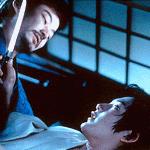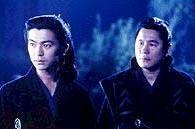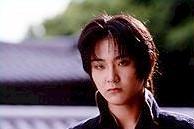|
|||||||||||||||||||
|
Gohatto The year is 1865, the place, Kyoto, one of Japan's ancientcapital cities. At the training hall of the Shinsen-gumi troop, head-quartered at a large Buddhist temple, a match is under way totest the fencing skill of new applicants. Leader Isami Kondo and his lieutenant Toshizo Hijikata observe. Soji Okita, the troop's best fencer, tests the applicants. Two are accepted: Sozaburo Kano, a handsome young fencer from a townsman's family in Kyoto, and Hyozo Tashiro, an ex-Kurume Clan low-ranking samurai. The Shinsen-gumi was founded three years earlier by the Tokugawa Shogunate, recruiting fencers from throughout Japan,to control increasing radical samurai activity and maintain peace in Kyoto; its major purpose being to suppress anti-Shogunate, revolutionary movements. The troop's rules hang prominently on the wall of a large room where the members live together. The rules symbolize the situation in which the men are placed: They are strictly bound by their severe code. Reading them, Tashiro asks Sozaburo, "Why did you join the Shinsen-gumi?" Sozaburo merely smiles. Ever since the day they enlisted, Tashiro has been enchanted by Sozaburo's unique charm. The following day, one of the Shinsen-gumi members must be executed for breaking the rules. Kondo names Sozaburo as executioner. The youth beheads the prisoner, without getting a drop of blood on himself, and performs his duty calmly. Kondo admires Sozaburo, saying, "He has courage." But Hijikata feels something different from courage in Sozaburo. A month after Sozaburo joined the Shinsen-gumi, his beauty causes rumors like, "Sozaburo is still a virgin," "Tashiro is making advances at Sozaburo but he avoids Tashiro" and "Sozaburo still keeps his hair in a boyish style. That means he has homosexual tendencies"... One day, Hijikata tells Sozaburo and Tashiro to stage a fencing match. Obviously Sozaburo is a better fencer, but somehow weakened, he is beaten by Tashiro. Observing them, Hijikata is convinced that the two have a homosexual relationship. Another man intently gazes at the match: Tojiro Yuzawa, who is enchanted by Sozaburo. In autumn, Kondo and a few of his men set out on a trip to the Choshu Clan, the Mecca of anti-Shogunate movements, to reprimand it. During Kondo's absence, an incident takes place: Sozaburo gets acquainted with Genzaburo Inoue, one of the Shinsen-gumi's leaders. While the Shinsen-gumi consists of mostly radical young men, Inoue, a little over forty and carefree, has a unique character. He hails from the same province as Kondo, Hijikata and Okita and studied fencing at the very school they did. Also, Inoue is a farmer's son like Kondo and Hijikata. Ever since the Shinsen-gumi was founded, Inoue has been one of its main leaders. Thus, some of the members gossip that the four actually dominate the troop. But unlike the other three, Inoue is a poor fencer. One day, Sozaburo must practice fencing with Inoue. Because Sozaburo allows for Inoue's inferior skill, their practice proceeds in an awkward way. Two anti-Shogunate samurai happen to see them and laugh, saying, "Is that all the Shinsen-gumi can do?" The preceding year, anti-Shogunate samurai held a secret meeting at an inn called Ikedaya. The Shinsen-gumi knew and raided the inn. As a result, the Shinsen-gumi gained the reputation of being a strongarm gang. Sozaburo regrets having disgraced the Shinsen-gumi.Taking advantage of his restless psychological condition, Yuzawa forces homosexual relations with Sozaburo. On their way, Tashiro walks beside wounded Sozaburo, calling his name again and again. Captured by jealousy, Yuzawa glares at them. Kondo returns to Kyoto in winter and on a snowy day, Yuzawa is found murdered. Instructed by Hijikata, Yamazaki launches an investigation but can find no clue to the assassin's identity. In spring, Hijikata orders Yamazaki to have Sozaburo lay a woman, as Kondo fears that homosexuality might prevail among the Shinsen-gumi members. Yamazaki repeatedly invites Sozaburo to a brothel, but he refuses. Sozaburo misunderstands, thinking that Yamazaki wants to seduce him. But after a month, Sozaburo begins to act friendly toward Yamazaki. Keeping himself from being dazzled by Sozaburo's charm, Yamazaki introduces a prostitute to him. Believing that his love for Yamazaki will be fulfilled, Sozaburo rejects the prostitute, causing a commotion. That night someone bushwhacks Yamazaki on his way home. His counterattack drives the would-be assassin away, but the latter drops a knife at the scene. Yamazaki investigates and learns that the knife belongs to Tashiro. Kondo knows and decides that Tashiro must be killed. He designates Sozaburo as the executioner and tells Hijikata and Okita to help him. As night falls, Hijikata and Okita wait at the river where the assassin will be killed. Okita mentions that, if someone tries to stand between Kondo and Hijikata, the offender must be killed. He relates to Hijikata, "Pledge of the Chry-santhemum," an episode of homosexuality in the "Tales of Ugetsu," a collection of ghost and mystery stories. Hearing, Hijikata imagines the relations of several men with Sozaburo. Sozaburo and Tashiro appear at the river. A swordfight ensues. Suspected of murdering Yuzawa and assaulting Yamazaki, Tashiro yells, "You did it! You stole my knife and planted it!" Enraged by his betrayal, Tashiro attacks Sozaburo. When Tashiro has cornered Sozaburo and is ready to kill him, Sozaburo murmurs, "Forgive me..." Hearing, Tashiro weakens and Sozaburo slashes him to death. In a drizzle, Hijikata and Okita leave the scene. Telling Hijikata, "I remember I have something to do," Okita goes back. Knowing Okita plans to murder Sozaburo, Hijikata is beset by unidentifiable emotion. Furious, he shouts, "Monster!" and swings his sword. A nearby cherry sapling slowly falls. Hijikata stands amid scattering cherry blossoms in the rain. Two years later, the Tokugawa Shogunate loses to Imperial forces, ending the age of samurai. Japan sets out on the road to modernization. Isami Kondo is executed. Toshizo Hijikata and Genzaburo Inoue are killed in battle. Okita dies from illness. Only seven years after its foundation, the curtain is drawn on the Shinsen-gumi. Visit the web site: http://www.shochiku.co.jp/gohatto/index_e.html Gohatto Source : Obtained from Planetout.Com |


